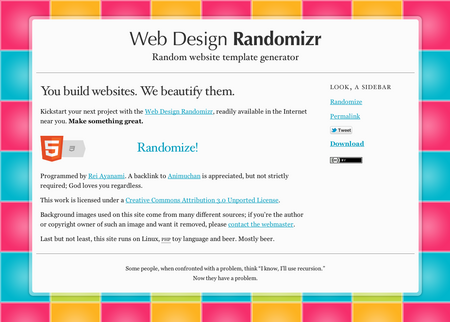Play with fonts?
 Hello, web designers Habrahabr.
Hello, web designers Habrahabr. We bring to your attention a thing in which you can play fonts frantically (and not only) - Web Design Randomizr . She appeared by chance, thought completely differently, it turned out something completely third, in general, nothing remarkable.
An example of what she does is visible in the image on the right, if it loaded.
A small digression: the author of this text, to the great joy of others, is not a designer. Typography and usability are very interesting to me, but at work I do things that are infinitely far from beautiful.
So, when an inexperienced web designer (for example, me) needs to draw a website, he takes some random fonts, colors, background image and looks at what happened. Then he throws it out, repeats random sampling, looks again. At some point it turns out inevitably; this workpiece goes to work, being gradually finished to a state where you can look at it without tears. Well, or almost without tears, sometimes crying is useful, by the way.
The first thing I wanted to do with this process, when I fully realized it, was, of course, to automate. And then it turned out that everything is not so simple: a living person with at least one eye makes a random choice not from all possible parameter values, but from an empirically selected range. For example, the text color is selected in contrast to the background color; Some colors are never used. This is amazing and wonderful, but how can such decision-making be turned into an algorithm?
A logical idea emerged as a whole: to write a parser that crawls on the Internet, collects the styles that other people have already written for us, and sort them by area of application. There are many styles, some random combination with such a sample is no longer plagiarized, but quite an investigation.
The parser has not yet taken shape, but this did not stop to make some trial implementation on a small data sample, in order to see if the original idea is good. I represent her to the public at large.
The work is by no means finished, and many parameters are set so far by carefully chosen at random constants. The result of the script every time is random; you can save it to disk, or save a permalink, or not save.
Well, the most important question that currently torments me. Do you think this approach to website design has the right to life?
